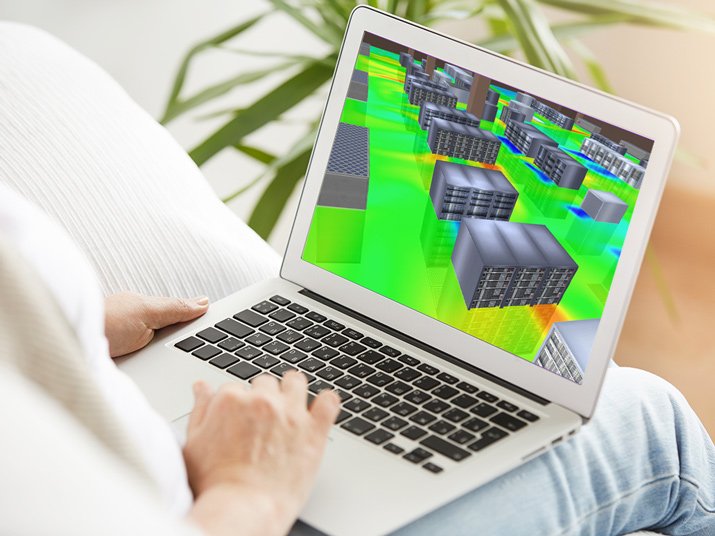Computational Fluid Dynamics (CFD) is a study used to solve problems related to fluid flow. Factors like velocity, density, chemical composition, etc., can influence fluid flow. Therefore, values obtained from CFD services can be used in various applications, especially in data centers, to evaluate fluid flow in normal and adverse conditions.
This technology is used in various fields to simulate and study models without physical prototypes. Being able to analyze structures and fluid flow using this method is far cheaper and less time-consuming as opposed to physical prototyping.
Five CFD Service Applications in Data Centers

CFD services are predominantly used in the design and construction phase of Data Centers in various aspects discussed in this article. Mechartes CFD Simulation experts have worked on several CFD Services to analyze the fluid flow and determine design and construction scopes for data centers.
1. Simulating rotating machinery using CFD
Rotating machinery with cyclic load acting on the structures such as compressors, steam pumps, gas turbines, and turbo-expanders. A labyrinth seal is used to rescue leakage flow in these types of machinery. If the seals are not efficient enough, the gas passes through the seals and causes unstable rotor vibration. CFD is used here to determine the dynamic rotor force that causes instability.
2. CFD simulation for laminar and turbulent flow
Turbulence or sudden movement on air, water, or liquids is not a good sign. In data centers, turbulence can occur due to earthquakes. Which can affect the functioning of HVAC systems and energy systems in the data center.
CFD simulation is used to study the turbulence on a CAD engineered design. Generalized k-omega (GEKO) in ANSYS is a common turbulence simulator used to study the effect on fluids and airflow. GEKO helps to simulate various types of turbulence effects and allows engineers to specify the parameters while maintaining model calibration.
3. Heating, air conditioning, and ventilation (HVAC) applications of CFD simulation
The servers and other IT equipment are kept cool in data centers to prevent excessive heat damage. To ensure that the rooms and spaces are well ventilated and conditioned and maintain indoor air quality, HVAC systems are analyzed using CFD to study the physics of fluid dynamics and the effect of outdoor and indoor factors on conditions in the space.
After rigorous testing and analyzing the space and airflow, HVAC diffusers, air handling units, FTUs, and other cooling methods are implemented. Finally, CFD services visualize the models and test their efficiencies without physical prototypes.
4. Heat transfer and thermal management simulation in CFD
Heat transfer and thermal management solutions study how heat moves through solid-fluid designs. Conduction, convection, and radiation are studied to see elements that can fit inside a data center space.
Thermal management ensures that the structural integrity of components is maintained. For example, IT equipment is kept closer in data centers, leading to heat from each server radiating to the other and heating the nearby servers. To prevent this, heat transfer and thermal management can be used.
CFD services study these phenomena and take necessary actions to maintain optimal temperatures throughout the facility.
5. Pipe and valve simulation with CFD
In data centers, cooling liquid can be flowing through pipes and valves. Fluid flow can exert high pressure and may lead to a disintegration of the structure of lines and valves if not appropriately monitored.
Before the components in the systems were installed based on guesses and extensive use of physical prototypes was needed to prevent significant functions of the system. With CFD services, entire piping systems or individual parts can be examined to determine their performance and analyze the structural integrity.
Also, read this case study on Pulsation Analysis in High Pressure Petroleum Piping Network
Benefits of Using a CFD Simulation Expert
When designing a data center, there are a lot of conditions and criteria that have to be fulfilled. Depending on the data center tier level, the cooling and power units will be accommodated to balance the redundancy.
Using 2n or more redundancy, most data centers will require additional cooling units and techniques to facilitate maximum optimal temperatures. Failing to provide adequate cooling can lead to systems heating up and shutting down. It can also cause harm to system hardware, start fires in case of short wires, etc. it can cause damage to expensive IT equipment and personnel inside the facility.
Sustainable utilization of resources, cooling units can help save immense power as cooling equipment consumes a huge chunk of energy next to IT equipment. Unfortunately, energy costs can pile up over time and become more expensive than the estimated cost in most cases.
To prevent all these mishaps, CFD analysis by a Simulation expert can help pay off in the long run. They can carefully analyze the needs of your data center, determine the cooling loads and their energy requirements and prescribe the best methods and techniques for optimized and sustainable cooling.
Mechartes and its team of simulation experts have used their CFD services for structuring cooling plans for data centers globally. They analyze the internal and external conditions of the facility to provide the best designs to maintain temperatures inside the facility while maintaining interior air quality in check at all times.
Mechartes CFD services are vital to small and large data centers looking to build with the best design practices. Their designs are suited for both new and expanding data centers. By keeping your needs and other conditions in mind, Mechartes simulation experts can help you find the best solutions for your data center cooling and energy needs. Get in touch today!


 Share
Share  facebook
facebook